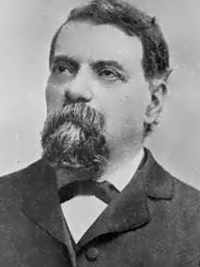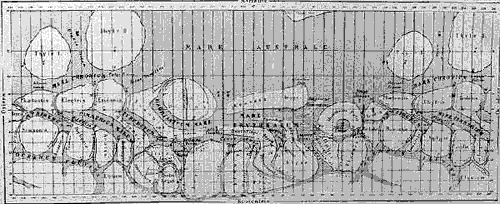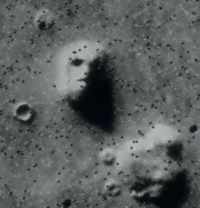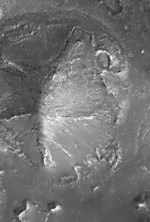
EXPLORING MARS
Optical Illusions 1
The Martian Canals: A Saga of Martians and Mistakes
By the mid-nineteenth century, telescopes were good enough and big enough to see detail on Mars. Astronomers were eager to study the Red Planet, as it was a common belief that people must live on other worlds, much as they did on Earth. True they might look a little different, but they must certainly be there. Or so many Victorians thought.
 Mars was seen to be orange-brown but there were variations in colour and most interestingly, there were icecaps. The fuzzy patches of dark and light brown-orange changed with the Martian seasons. The conclusion was that this must be due to changes in vegetation growth.
Mars was seen to be orange-brown but there were variations in colour and most interestingly, there were icecaps. The fuzzy patches of dark and light brown-orange changed with the Martian seasons. The conclusion was that this must be due to changes in vegetation growth.
In 1877 an Italian astronomer named Giovanni Virginio Schiaparelli announced to the world that he could clearly see "Canali" or channels in the surface of the planet. He produced a map. He hadn't been the first to see the phenomenon, but he was the first to publicise it. Canali literally means channel in the Schiaparelli translation, but the English-speaking press interpreted this as "canal". Of course canals are man-made, and this could only mean that Martians had built them! Schiaparelli even reported in 1879 that some of the canals had become double, since his initial sightings. He too, seems to have become caught up in his own myth.

Schiaparelli's Map of 1877
The myth grew: the lines were straight, so must be artificial. Mars was dry-looking, so there must be a water shortage. The people of Mars had built irrigation channels to take water from the poles to the arid equator. These canals, it was estimated, were of massive proportions. The Martians were supermen, with far superior technology to that of Earth! Books were written describing in great detail, what the Martians looked like, how they behaved and how their civilisation worked.
Seven years later, two French astronomers, Perrotin and Thollon confirmed Schiaparelli's observations. After this dozens of observers reported seeing canals. The strange thing was however, that others using equally powerful telescopes, failed to see anything that looked vaguely like canals or even lines. This should have been a clue to the reality, and a warning to the over-imaginative.
 The debate however seemed ended when Percival Lowell entered the scene. Lowell was a rich businessman, more or less retired and with a passion for astronomy. He built his own observatory on a clear mountain summit near Flagstaff Arizona, primarily for Mars-watching. He constructed one of the largest telescopes ever made, until that time, and concentrated on producing detailed maps of his Red Planet. He reinforced the debate in favour of the existence of the canals, by showing how the intricate canal system functioned. Lowell was a powerful publicist and an advocate for astronomy. We are heavily indebted to him for bringing the subject to public attention and creating interest in space, in general. We also have his invaluable legacy in Arizona: the Lowell Observatory is now one of the world's leading astronomical institutions.
The debate however seemed ended when Percival Lowell entered the scene. Lowell was a rich businessman, more or less retired and with a passion for astronomy. He built his own observatory on a clear mountain summit near Flagstaff Arizona, primarily for Mars-watching. He constructed one of the largest telescopes ever made, until that time, and concentrated on producing detailed maps of his Red Planet. He reinforced the debate in favour of the existence of the canals, by showing how the intricate canal system functioned. Lowell was a powerful publicist and an advocate for astronomy. We are heavily indebted to him for bringing the subject to public attention and creating interest in space, in general. We also have his invaluable legacy in Arizona: the Lowell Observatory is now one of the world's leading astronomical institutions.
But Percival Lowell was a poor observer...
The truth about the canals lay not on Mars but in the ocular aberration of the eye and in the telescopes of the time. By the early part of the twentieth century, the canals were no longer visible to the leading astronomers who were using the best telescopes. But Lowell's legacy was a powerful force, supported by wish-fulfilment and science- fiction. It wasn't really until the Mariner spacecraft gave conclusive proof of the true nature of Mars, that the Martian myth was expelled. But even then it didn't lie still for long... but that is a different story.
The great irony is that Mars is indeed covered in dry water channels, but these were too small to show up in the telescopes of the Victorian astronomers - indeed, even the mighty Hubble Space Telescope can only just make out the largest canyons, such as the Valles Marineris. In a way the pioneers were right, but for the wrong reasons, based on complete misinformation - a result of the shortcomings of the human eye.
Optical Illusions 2
Facing the Facts

Many of the Viking images were put straight into storage and not looked at when they were received - there were just too many to examine and only a few experts to do the work. In July 1976 Tobias Owen was looking through the pictures and found this one Number 35A72(above). It is the original raw image, complete with "noise" - the black specs.
A face. What did it mean? It was soon found to be a couple of kilometres in length and located in the region of Cydonia, in the northern lowlands.
It caused much excitement and press speculation at the time. Who made it? Didn't it look like an Egyptian? Was it a message to us? Had it been built by aliens? Had mankind already been to Mars sometime in the pre-history?
All this was fuelled even further, when detailed examination of other images of the locality revealed five-sided pyramids, rectangular piazzas and enormous buildings and fortifications laid out in logical or geometric patterns. Or so it was claimed by some people who examined the images.
Theories abounded, books were written, fortunes were made. Entire new civilisations were created, both alien and Earthly. These were described in great detail. In some cases even accounts of the history and science of the people were included. Of course, all this had been built on the back of a few not-very-detailed photographs, and some active imaginations. The hype and misinformed public acceptance of Lowell's Mars was repeated, but this time it was in the age of high-science, instant media and after a century-worth of mass education - a time when we should have known better. Apparently no lessons had been learnt from the Martian canals fiasco!
Most astronomers, planetary scientists and the world's space agencies dismissed these wild ideas completely, of course, saying at best the notions were highly speculative or extremely unlikely. Some refused even to comment. Meanwhile the new Martian myth grew, in anticipation of the Truth being revealed... And it was, in no uncertain terms.
In March and April 1998 the Mars Global Surveyor re-photographed Cydonia in great detail and returned the images below.


The Face, rotate it and what does become? Just another hill.

The so-called city square - No city and it isn't even square.

One of the five-sided pyramids - perhaps just a volcanic structure modified by the wind, but perfectly natural. A similar but bigger structure can be seen just east (right) of the Ceraunius Tholus volcano, which is the large cone in the centre of this Viking image below.


No comments:
Post a Comment